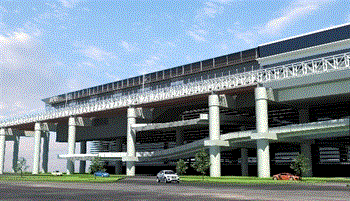
Completed in July 2014, Toronto’s $159 million CDN PanAm Aquatics Centre seats approximately 6,000 and features two internationally sanctioned 10-lane pools, international diving facilities and dry-land high-performance training facilities.
 By David Morley, senior vice president, Infrastructure Ontario
By David Morley, senior vice president, Infrastructure Ontario - July 17, 2015
On May 13, 2015, the Metropolitan Planning Council, Brookings Institution and Union League Club of Chicago hosted Broke, Broken and Out of Time—a half-day conversation highlighting the critical importance of investing in and modernizing America’s infrastructure systems. This blog series features interesting and timely ideas for infrastructure solutions in Chicagoland.
Ten years ago, Ontario faced challenges in delivering its biggest infrastructure projects on time and on budget. Public leaders began looking for a better way to renew infrastructure.
In 2005, the provincial government formed an agency called Infrastructure Ontario and tasked it with delivering the large and complex public infrastructure projects using a model called Alternative Financing and Procurement, which is the made-in-Ontario approach to public-private partnerships.
Since then, Infrastructure Ontario has used Alternative Financing Procurement to build new public assets—hospitals, courthouses, detention centres, provincial police facilities, highways and transit. Of our first 37 projects, 36 were delivered on budget—a 97 percent record. Along the way, we learned that there are a number of ingredients to success in delivering an ambitious infrastructure program.

The Union Pearson Express Line, completed in the summer of 2014, connects Toronto’s public transit with Terminal 1 of Toronto Pearson International Airport. It was built through a $129 million CDN Alternative Financing and Procurement contract.
Our approach to major projects has a strong foundation. Infrastructure Ontario was created in legislation, has an independent Board of Directors and is accountable to the government. There are a number of principles that guide our approach—including that assets must be publicly owned and value for money must be demonstrated.
Equally important is that we have created a program that is reliable for the government and the marketplace. This involves using standard competitive procurement processes and template documents, and bringing to market a pipeline of projects. Regular dialogue with industry about enhancements and improvements to the program is also important.
We are pragmatic and recognize the potential risks of cost overruns and schedule delays in projects, and focus on transferring risks from the public sector to the private sector. No one in the project management business looks at large and complex projects on a risk-free basis anymore. Most recognize that traditional ways of doing things left the public sector with too many risks and very little leverage when projects ran into trouble.
Our use of Alternative Financing Procurement for complex projects means that we don’t break large projects up. As an example, builders are required to design the projects to meet the project specifications and approach all elements in an integrated way. This encourages innovation, which can increase design excellence and reduce costs. And taxpayers are better protected from costly change orders that can come from deficiencies in design.
In addition, private financing is a tool to encourage performance. Payments are made based on performance, so that the private sector is motivated to get the job done on time, on budget and according to the specifications. Builders also are accountable for long-term quality since they are paid a portion of the construction cost over time. We have found that the benefits of this financing outweigh the costs.
Infrastructure Ontario and Ontario’s representative in Washington D.C. often share our experience and successes with other jurisdictions. We did so with Illinois at venues such as the Great Lakes Economic Forum, the National Governors Association Centre of Excellence workshop and the Metropolitan Planning Council infrastructure event.
Looking ahead, Infrastructure Ontario’s 2015 Market Update contains 20 projects—an increasing number of which are related to transit and transportation—with an estimated capital value of $7.55B CDN. We look forward to using Alternative Financing Procurement and sharing lessons learned about how public infrastructure projects can be delivered successfully.
David Morley is a senior vice president at Infrastructure Ontario.